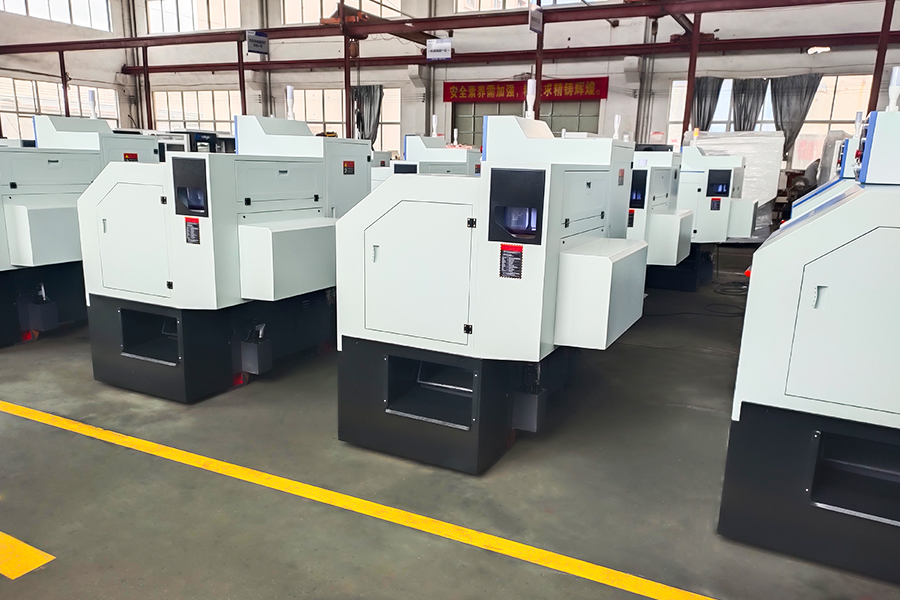Technical Characteristics: The machine tool is of high precision, and the spindle is supported by hi...
See Details
In the realm of computer numerical control (CNC) machining, lathes are fundamental tools used for a wide range of manufacturing tasks. Two prominent types of CNC lathes are flat-bed and slant-bed lathes. Each type offers distinct advantages and disadvantages, and understanding these differences can help manufacturers choose the suitable machine for their specific needs.
Flat-Bed CNC Lathes: Advantages and Disadvantages
Flat-bed CNC lathes, as the name suggests, feature a horizontal, flat bed upon which the workpiece is mounted. This traditional design has been used in various machining applications and offers several advantages.
Advantages:
Stability and Rigidity: The flat-bed design is known for its stability. The flat, horizontal surface provides a solid base, which helps maintain rigidity during the machining process. This stability is particularly beneficial for producing high-precision parts, as it reduce vibrations and deflections.
Ease of Setup and Operation: Flat-bed lathes are often simpler in design compared to their slant-bed counterparts. This simplicity can make them easier to set up and operate, particularly for operators who are familiar with traditional lathe configurations. The straightforward design also means that maintenance can be more manageable.
Versatility: Flat-bed CNC lathes are versatile machines capable of handling a wide variety of workpieces. They are suitable for both small and large parts, making them a good choice for diverse machining tasks.
Disadvantages:
Chip Removal Challenges: One notable drawback of flat-bed lathes is the potential difficulty in chip removal. As chips and debris accumulate on the flat bed, they can obstruct the machining process and impact the quality of the finished part. Effective chip management systems are necessary to address this issue, but they may add to the complexity and cost of the machine.
Limited Access to Workpieces: The flat-bed design may limit access to certain areas of the workpiece, particularly when machining complex shapes or deep holes. This limitation can require additional setups or fixtures, potentially increasing the overall time and cost of production.
Space Requirements: Flat-bed lathes generally have a larger footprint compared to slant-bed models. This larger size may necessitate more floor space in the workshop, which could be a concern for facilities with limited space.
Slant-Bed CNC Lathes: Advantages and Disadvantages
Slant-bed CNC lathes feature a bed that is angled, typically between 30 to 45 degrees. This design approach offers several distinct advantages and some trade-offs.
Advantages:
Improved Chip Removal: The slanted bed design facilitates better chip removal. The angled surface helps gravity assist in directing chips away from the cutting area and the workpiece, bring about a cleaner machining environment and reducing the risk of chip-related interruptions.
Enhanced Access and Visibility: The slant-bed design often provides better access to the workpiece, making it easier to machine complex shapes or deep features. Improved visibility during the machining process can enhance precision and reduce setup times.
Compact Footprint: Slant-bed lathes are generally more compact than flat-bed lathes. Their design allows for a more efficient use of space, making them well-suited for workshops with limited floor area.
Disadvantages:
Increased Complexity and Cost: Slant-bed lathes typically have a more complex design compared to flat-bed models. This complexity can bring about higher initial costs and potentially more challenging maintenance. Additionally, the angled bed may require specialized training for operators who are accustomed to flat-bed lathes.
Limited Versatility: While slant-bed lathes are for specific types of work, they may not be as versatile as flat-bed lathes. The design is optimized for certain applications, and the machine’s configuration may limit its adaptability to a broader range of machining tasks.
Initial Setup and Alignment: The angled bed design can make the initial setup and alignment of the workpiece more challenging. Precise alignment is critical to achieving accurate results, and any misalignment can impact the overall quality of the finished part.

Our team of digital and business experts will guide you to the right direction.
Let's Talk